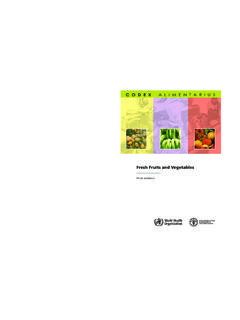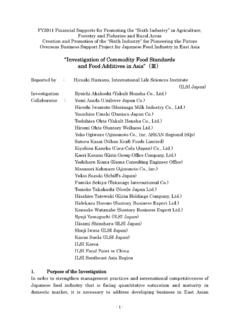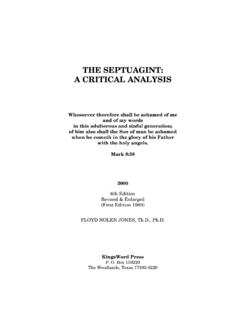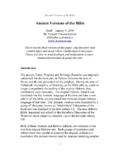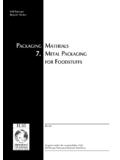Transcription of FOOD SAFETY USING HACCP QUALITY …
1 Food Promotion Chronicle, 2006 FOOD SAFETY USING HACCP QUALITY management system Naresh L , Shailaja U. Merchant and Nikunj C. Dhuldhoya Lucid Colloids Limited, B 5/7, MIA, Basni, Phase I, Jodhpur-342005 (Rajasthan), India INTRODUCTION Food business is one of the fastest growing industries in India. The opportunities for success are greater than ever. While food contamination can happen after food has been bought and taken home, some food industries are still having problems in consistently providing safe food. Therefore we need an approach that will address the basic issue of how to achieve safe food all the time.
2 Food SAFETY is about making sure that food products are safe to eat. Put simply, it means taking care with all aspects of food production and preparation to make sure that the final product is safe without any contamination. A preventive approach to food SAFETY ensures that the manufacturer examines every stage of the process, identify the essential procedures and make sure process standards / parameters remain consistent. The way to do this is to establish and maintain a food SAFETY programme. If your food is safe you can be confident that your business will be safe.
3 Your customers will place their confidence in food produced under a food SAFETY programme. WHAT IS FOOD SAFETY PROGRAMME? A food SAFETY programme is a set procedure to produce safe and hygienic food every time. It involves a thorough examination of a process in order to identify and control the hazards that could make the food you produce harmful to eat. Simply stated it asks What might go wrong, and how do I make sure it doesn t? . Food SAFETY programme make sure that all the people working in your business are committed to producing safe and hygienic food by involving Corresponding Author: email: in the entire production, processing and distribution stage of the product.
4 Food SAFETY problems become easier to spot before they happen which leads to confidence in your product, because you will have control over the process. General Objectives of Food SAFETY Programme: Identify the essential principles of food hygiene applicable throughout the food chain (starting from raw material reception to final product), to achieve the goal of ensuring that food is safe and suitable for human consumption. Recommend a HACCP based approach as a means to enhance food SAFETY . Indicate how to implement those principles.
5 Provide guidance for specific codes which may be needed for sectors of the food chain, processes or commodities to amplify the hygiene requirements specific to those areas. Food SAFETY programme will need an expert technical advice to help in identifying the hazards and to take necessary controls. Internationally it is recognized that the ideal tool to give assurance of food SAFETY is the Hazard Analysis Critical Control Point ( HACCP ), a Food SAFETY QUALITY management system . HACCP system HACCP is an abbreviation for the Hazard Analysis Critical Control Point, which is synonymous with food SAFETY management .
6 It is a system which identifies, evaluates, and controls hazards which are significant for food SAFETY . HACCP is a system that gives confidence that food SAFETY is being managed effectively. HACCP was developed originally as a microbiological SAFETY system in the early days (1960s) of the US manned space programme, as it was vital to ensure the SAFETY of food for astronauts. The Pillsbury Company working alongside the National Aeronautics and Space Administration (NASA) of the USA and the US Army Laboratories developed the original system .
7 A Hazard as used in the HACCP system is defined as a biological, chemical or physical agent in, or condition of food, with the potential to cause an adverse health effect . Critical Control Point (CCP) is a step at which control can be applied and is essential to prevent or eliminate a food SAFETY hazard or reduce it to an acceptable level . HACCP is based on the principle that hazards affecting food SAFETY can be either eliminated or minimized by prevention during production rather than by inspection of the finished product.
8 Its goal is to prevent hazards at the earliest possible point in the food production or distribution chain. The HACCP approach can be applied right from harvest to the point of consumption. Adding HACCP to traditional inspection and QUALITY control activities would lead to a preventive QUALITY assurance system in a company. Companies USING the HACCP system will be able to provide greater confidence about food SAFETY to consumers as well as to food regulatory authorities. The application of HACCP may require a fundamental change in the culture or attitudes of those involved in food processing.
9 It also requires focused record keeping and documentation even though many of the procedures to be documented themselves may remain unchanged. It is very important that all the people working in the company understand the HACCP system and that they maintain it. The adoption of HACCP simply to satisfy a regulatory requirement has the potential to lead to failure in that company. The HACCP system and guidelines for its application were developed by the Codex Committee for Food Hygiene on the Codex Alimentarius Commission, a joint Food Standards Programme of the Food and Agriculture Organization (FAO) of the United Nations and the World Health Organization (WHO).
10 PRINCIPLES OF HACCP It is important to identify the possible hazards that can occur at every stage of the food business from growth, processing, manufacturing, storage and distribution, until the point where it is sold to the customer. As far as possible manufacturer should consider how the customer might handle it too. The HACCP system consists of seven principles, which outline how to establish, implement and maintain a HACCP plan for the operation under study. Principle 1: Identify hazards Identify potential hazards (microbiological, chemical and physical) associated with all stages of the production, USING a flow diagram of the steps applied in the process.

